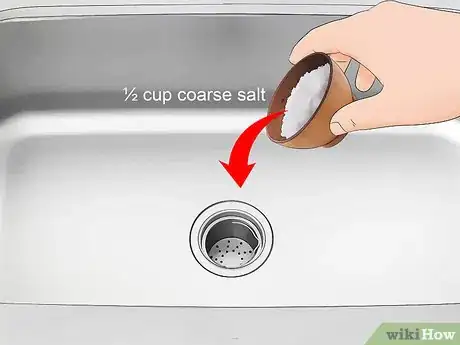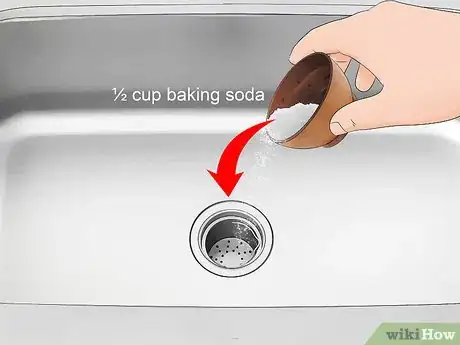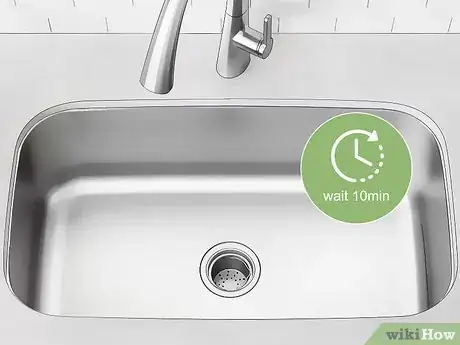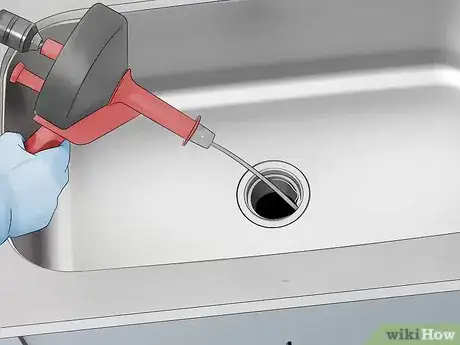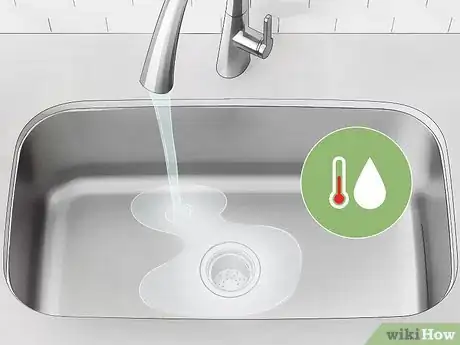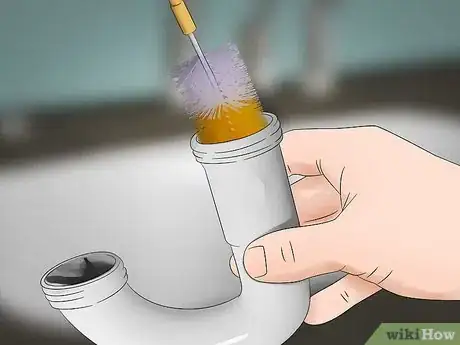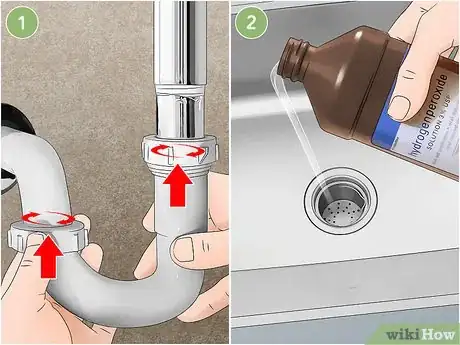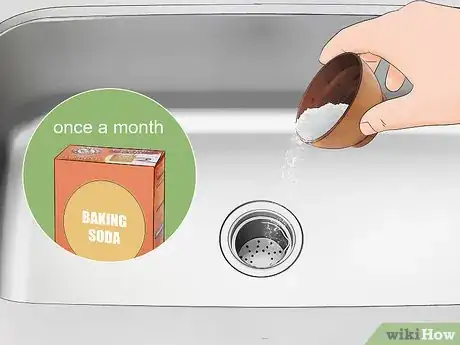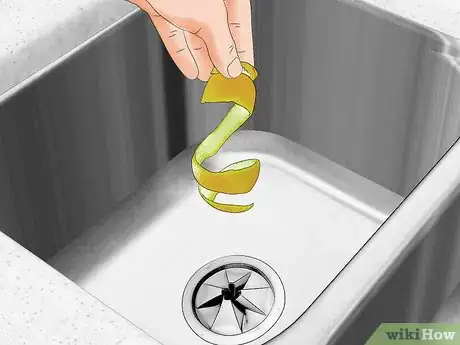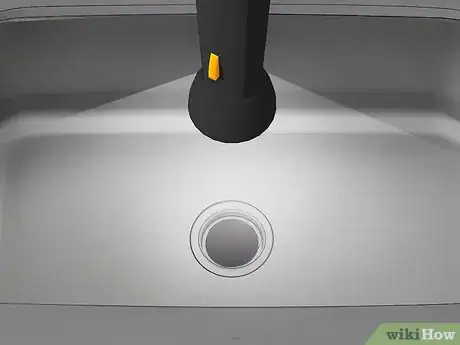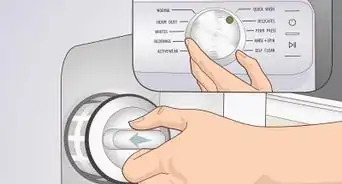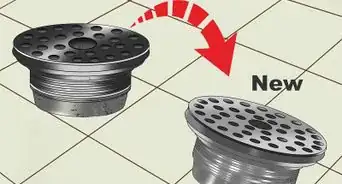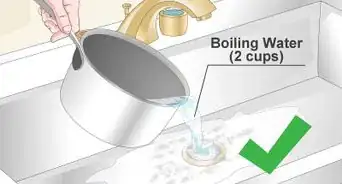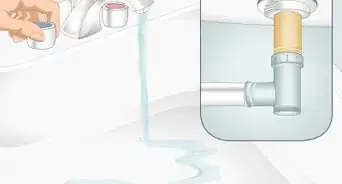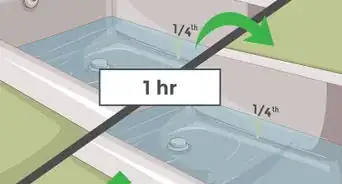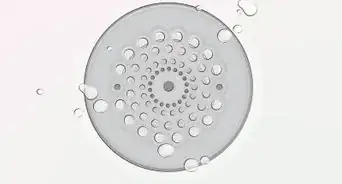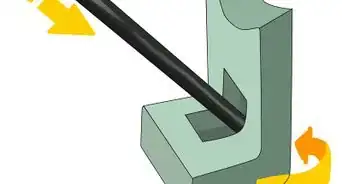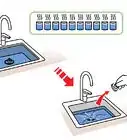This article was co-authored by Michelle Driscoll, MPH. Michelle Driscoll is the Owner of Mulberry Maids, which is based in Fort Collins, Colorado. With five years of experience, her business specializes in cleaning homes and small offices. She holds a Masters in Public Health from the Colorado School of Public Health. Additionally, Mulberry Maids has an A+ rating from the Better Business Bureau.
There are 10 references cited in this article, which can be found at the bottom of the page.
This article has been viewed 101,944 times.
Catching a whiff of a stinky drain is unpleasant, but most drains can be cleaned without harsh chemicals. Smelly drains are often the result of buildup from hair, soap, grease, food, and other debris. The classic way to handle this problem is with vinegar or lemon juice. For stubborn clogs, use a drain auger to clear most drains or take apart the P-trap to deodorize a sink drain. Then, treat your drain regularly to prevent foul odors and clogs from coming back.
Steps
Neutralizing Odors with Baking Soda
-
1Pour hot tap water down the drain. Turn the tap to the hottest water setting possible and let it run for a few minutes. The hot water will loosen soap scum and any other foul-smelling debris in the drain.[1]
- If using the tap isn’t an option, heat a pot of water on the stove. Remove the water from heat before it boils.
-
2Add ½ cup (133.6 g) of coarse salt to the drain. Salt acts as an abrasive on debris clinging to the sides of drains. Even if this debris isn’t the immediate cause of the smell, it eventually attracts smelly bacteria and even forms clogs.[2]
- Grains of coarse or kosher salt are much larger than grains of table salt, so they are more effective for clearing a drain.
Advertisement -
3Sprinkle ½ cup (90.0 g) of baking soda down the drain. Remove the cover or stopper if your drain has one. Pour the baking soda out gradually, trying to get as much of it as you can down the drain. A lot of it will end up on the sides where the unpleasant debris and bacteria collect.[3]
-
4Pour 2 cups (470 mL) of white vinegar or lemon juice down the drain. Both vinegar and lemon juice react to baking soda right away. Cover the drain with its stopper or place a towel over it to force the bubbling mixture down the pipe. The mixture will deodorize as well as treats impending clogs.[4]
- Heat the vinegar or juice on the stove or in the microwave first to give it more cleansing power.
-
5Wait at least 10 minutes for the cleaner to take effect. Running water through the drain pipe too soon washes away the cleaner, so give it plenty of time to settle in. Keep the drain covered to prevent air and any remaining cleaner from coming back up.[5]
- For greater effect, especially if you haven’t cleaned the drain in a while, leave the baking soda mixture in the drain as long as overnight.
-
6Flush the drain with more hot water. Turn on the hot water or heat another pot of it on the stove. Pour it down the drain, letting it wash away the cleaner and any gunk in the pipe. Most, if not all, of the odor will be gone.[6]
- For particularly nasty odors, you may need to do another flush. Repeat the treatment with more of the baking soda and vinegar mixture.
Clearing Clogs with an Auger
-
1Wash the drain plug to eliminate hair and other debris. Drain plugs are often a significant source of debris. Pull the plug out and examine the bottom end. If you see any gunk, rinse it off with water and a paper towel. Sprinkle it with baking soda or an alternative treatment to eliminate any remaining odors.
- Clean drain plugs often, at least once a month, to prevent buildup. Buildup like hair and grease not only makes the plug smell, but it may turn into a smelly clog inside the drain pipe.
- Spraying white vinegar on the drain plug also helps remove debris. Another option is to heat a pot of vinegar until it bubbles gently, then leave the drain plug in it for a few minutes.
-
2Break up the clog with a drain stick or auger. Shine a light into the drain to see how far down the clog is. Then, lower a drain-cleaning tool like a drain stick down to the clog. Plastic drain sticks are the cheapest tools available, and all you do is lower the stick down and pull it back up to remove the clog piece by piece. Wash off the tool and use it repeatedly until most of the material causing the clog is gone.[7]
- Create your own drain stick out of a wire hanger. Straighten it out, adjusting the end into a hook that fits down the drain. Then, use it to pull out hair and other material in the drain.
- For a more effective drain-clearing tool, purchase an auger or drain snake from a general store. Augurs are longer than plastic sticks and more effective at breaking up solid clogs. Rotate the auger in the drain to loosen the nasty gunk on the walls.
-
3Flush the drain with hot water to clear out the rest of the clog. Turn on the hot water and let it flow into the drain for several minutes. If the water flows freely down the drain, the clog is gone. If not, try using an auger or taking apart the drain pipe.[8]
- Boiling water can harm PVC pipe joints, so avoid pouring boiling water down the drain unless you’re sure your pipes are metal. Remember this if you need to heat a pot of water for drains without working taps.
Cleaning a Sink P-Trap
-
1Remove the sink drain trap if your drain is still clogged or smelly. The part you need to remove is the P-trap, which is an S-shaped component connecting the wall outlet to the sink’s tailpipe. It will have 2 nuts, which look like plastic or metal rings, securing it to these other pipes. Turn them counterclockwise with a wrench to loosen the P-trap. When it’s loose enough, you will be able to wiggle it down and off of the connecting pipes.[9]
- The P-trap will likely have water in it, so have a bucket or container nearby!
- The P-trap is usually visible underneath sinks. The P-trap will be underneath the floor or inaccessible with other types of drain. Try to treat the drain through another method or call a plumber to fix it.
-
2Wash the P-trap with a nylon bottle brush and a paper towel. Push the brush through the P-trap to clear out any clogs or grime responsible for the foul smell. To facilitate the cleaning process, wrap a paper towel around the brush. Then, push the paper towel through the P-trap to absorb the grime on its walls.[10]
- Bottle brushes are available at some home improvement and general stores. If you are unable to get one, try using a straightened wire hanger.
- Take a look at the connecting pipes as well. They often have smelly debris in them. Use a paper towel to wipe up debris and use an auger to break clogs.
-
3Clean the drain with hydrogen peroxide after reinstalling the P-trap. Set the P-trap back in place, twisting the nuts clockwise until they’re tightly in place. Then, mix 1 cup (240 mL) of hydrogen peroxide with 1 tablespoon (14.40 g) of baking soda. Pour the mixture down the drain to finish removing the remaining debris and odor.[11]
- Using baking soda or lemon juice is also an option for neutralizing the remaining odor.
Preventing Drain Odors
-
1Sprinkle the drain with baking soda at least once a month. Baking soda is very effective at absorbing odors. Add about 1 tablespoon (14.40 g) to each drain, particularly those you use often. For well-used drains prone to nasty smells, use baking soda more frequently to avoid problems.[12]
- Baking soda neutralizes odors, but it doesn’t break up clogs. Treat clogs as they form to prevent them from becoming an issue.
-
2Use lemon slices and peels to deodorize garbage disposals. Drop a lemon wedge or a few peels into the disposal. Activate the disposal, letting it grind up the lemon. The citrus scent will neutralize nasty odors from other foods and grime in the pipes. If you don’t have a lemon, this works with other citruses as well.[13]
- You can also try using ice to scour the blades and collect grease from your garbage disposal. Add salt or Borax to help deodorize the drain.[14]
-
3Flush drains with dish soap and hot water regularly. Flush drains once a week to prevent the buildup responsible for most smells. Cover the drain with a drain stopper, then run hot water from the tap. Mix in about 1 tablespoon (15 mL) of your regular dish soap. Unplug the drain to let the water wash away the debris.[15]
- Flush a drain right after using it. It washes away oil or food particles in your kitchen sink, for example, before they settle on the drain pipe.
- If your drain has a garbage disposal, activate the blades for more cleaning power.
-
4Remove potential clogs manually before they block the drain. Shine a flashlight into your drains to check for unpleasant buildup. If you see anything, use a drain tool or auger to scrape away the debris. This is very useful for shower drains that accumulate plenty of hair and soap scum over time.[16]
- Remember to check the drain stopper as well. Wipe it clean and treat it with vinegar or baking powder as needed.
Warnings
- Boiling water can damage PVC pipes. Avoid using hot water unless you’re certain your drain isn’t connected to any PVC components.⧼thumbs_response⧽
- Take precautions when using hot water. To avoid the risk of burns when heating water for a drain, wear long clothing and oven mitts. Carry the water to the drain carefully and pour it in slowly.⧼thumbs_response⧽
- Don’t use bleach in your drain if you have a septic system. The bleach can kill the bacteria in your septic tank that breaks down your waste.[17]⧼thumbs_response⧽
Things You’ll Need
Neutralizing Odors with Baking Soda
- Measuring cup
- Hot water
- White vinegar or lemon juice
- Baking soda
Clearing Clogs with an Auger
- Drain stick or auger
- Hot water
Cleaning a Sink P-Trap
- Bucket
- Wrench
- Nylon bottle brush or wire hanger
- Hydrogen peroxide
- Baking soda
- Measuring cup
Preventing Drain Odors
- Baking soda
- Lemon
- Dish soap
- Hot water
- Drain auger
References
- ↑ https://www.wideopeneats.com/8-hacks-to-rid-your-kitchen-of-funky-sink-odors/
- ↑ https://www.thekitchn.com/10-ways-to-get-rid-of-that-awful-smell-in-your-kitchen-sink-223627
- ↑ https://www.youtube.com/watch?v=E5vpTaWTuqQ&feature=youtu.be&t=5
- ↑ https://housewifehowtos.com/clean/how-to-clean-stinky-drains/
- ↑ https://www.youtube.com/watch?v=E5vpTaWTuqQ&feature=youtu.be&t=20
- ↑ https://www.bhg.com.au/how-to-get-rid-of-smelly-sink
- ↑ https://www.bobvila.com/articles/how-to-snake-a-drain/
- ↑ https://www.wideopeneats.com/8-hacks-to-rid-your-kitchen-of-funky-sink-odors/
- ↑ https://www.youtube.com/watch?v=xiuKTOkbF_o&feature=youtu.be&t=30
- ↑ https://www.youtube.com/watch?v=xiuKTOkbF_o&feature=youtu.be&t=104
- ↑ https://housewifehowtos.com/clean/how-to-clean-stinky-drains/
- ↑ https://www.thekitchn.com/10-ways-to-get-rid-of-that-awful-smell-in-your-kitchen-sink-223627
- ↑ https://housewifehowtos.com/clean/how-to-clean-stinky-drains/
- ↑ https://housewifehowtos.com/clean/how-to-clean-stinky-drains/
- ↑ https://www.thekitchn.com/10-ways-to-get-rid-of-that-awful-smell-in-your-kitchen-sink-223627
- ↑ https://www.bobvila.com/articles/how-to-snake-a-drain/
- ↑ https://moreventservices.com/how-to-make-homemade-drain-cleaner-to-fix-a-stinky-drain/
About This Article
To clean a smelly drain, start by sprinkling half a cup of baking soda down it, which will help get rid of unpleasant debris and bacteria. Alternatively, pour 2 cups of white vinegar or lemon juice down the drain. For the best results, heat the vinegar or lemon juice on the stove or in the microwave first. Whichever cleaner you use, give it at least 10 minutes to work. Then, flush the drain with water as hot as you can get it to wash the cleaner and any gunk out of the pipe. To keep the drain clean, try to repeat this process at least once a month so bad odors don't build up. For more tips from our Cleaning co-author, including how to deodorize your garbage disposal, read on!

